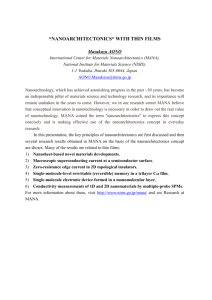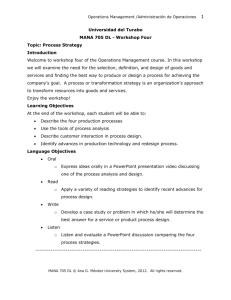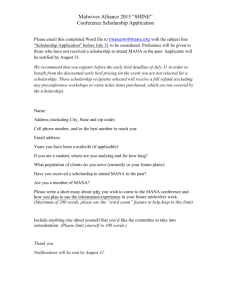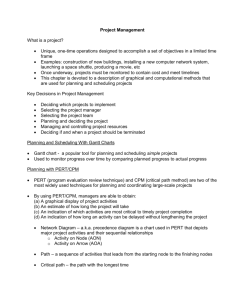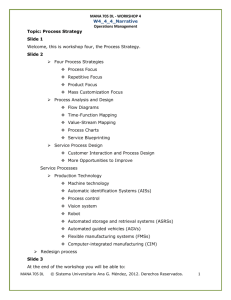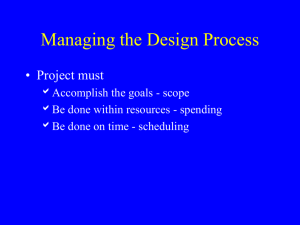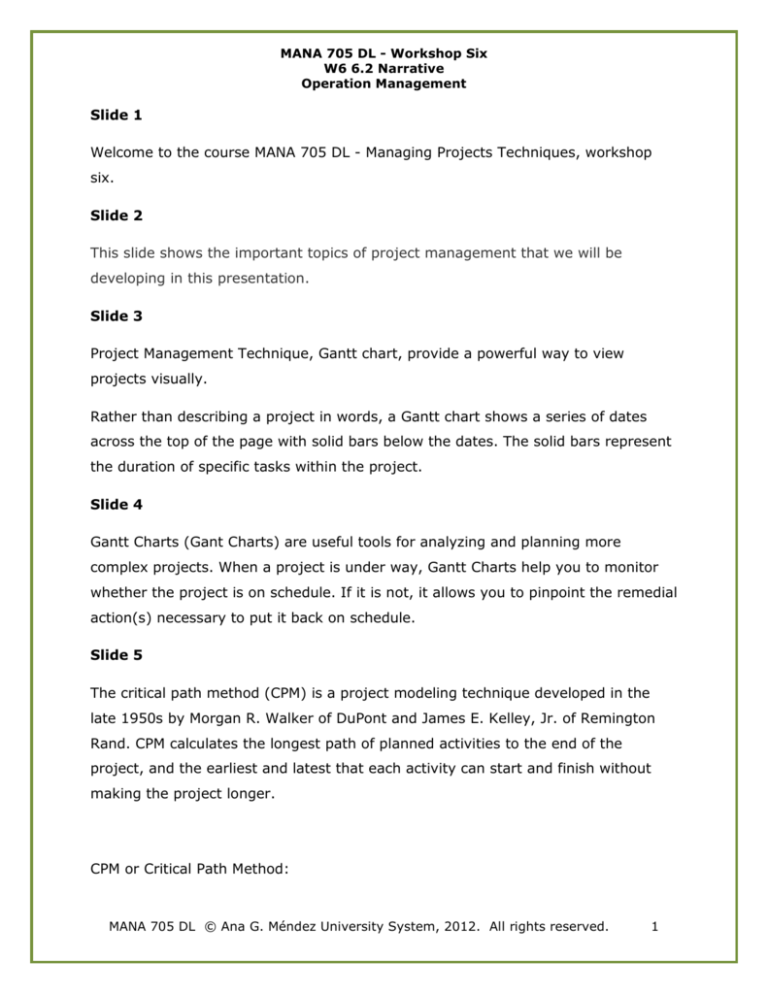
MANA 705 DL - Workshop Six
W6 6.2 Narrative
Operation Management
Slide 1
Welcome to the course MANA 705 DL - Managing Projects Techniques, workshop
six.
Slide 2
This slide shows the important topics of project management that we will be
developing in this presentation.
Slide 3
Project Management Technique, Gantt chart, provide a powerful way to view
projects visually.
Rather than describing a project in words, a Gantt chart shows a series of dates
across the top of the page with solid bars below the dates. The solid bars represent
the duration of specific tasks within the project.
Slide 4
Gantt Charts (Gant Charts) are useful tools for analyzing and planning more
complex projects. When a project is under way, Gantt Charts help you to monitor
whether the project is on schedule. If it is not, it allows you to pinpoint the remedial
action(s) necessary to put it back on schedule.
Slide 5
The critical path method (CPM) is a project modeling technique developed in the
late 1950s by Morgan R. Walker of DuPont and James E. Kelley, Jr. of Remington
Rand. CPM calculates the longest path of planned activities to the end of the
project, and the earliest and latest that each activity can start and finish without
making the project longer.
CPM or Critical Path Method:
MANA 705 DL © Ana G. Méndez University System, 2012. All rights reserved.
1
MANA 705 DL - Workshop Six
W6 6.2 Narrative
Operation Management
Tool to analyze project and determine duration, based on identification of
"critical path" through an activity network.
Knowledge of the critical path can permit management of the project to
change duration.
A single estimate for activity time was used that did not allow for variation in
activity times.
Activity times are assumed to be known or predictable ("deterministic").
Activities are represented as nodes or circles.
PERT or Project Evaluation and Review Technique:
A PERT chart is a project management tool used to schedule, organize, and
coordinate tasks within a project. PERT stands for Program Evaluation Review
Technique: a methodology developed by the U.S. Navy in the 1950s to
manage the Polaris submarine missile program.
Another derivative of the GANTT chart.
Multiple time estimates were used for each activity that allowed for variation
in activity times.
Activity times are assumed to be random, with assumed probability
distribution ("probabilistic").
Activities are represented by arrowed lines between the nodes or circles.
MANA 705 DL © Ana G. Méndez University System, 2012. All rights reserved.
2
MANA 705 DL - Workshop Six
W6 6.2 Narrative
Operation Management
Slide 6
The first step in PERT or CPM network is to divide the entire project into significant
activities in accordance with work breakdown structures. There are two approaches
for drawing a project network: activity on mode (AON) and activity on arrow
(AOA).The basic difference between AON and AOA is that the nodes in an AON
diagram represent activities. In an AOA network, the nodes represent the starting
and finishing times of an activity and are also called events.
Slide 7
Activity on Arrow usually uses an arrow to connect each activity from the start until
the end of the project. It might present a problem if the activity is too much and
too long. Other people not involved in project management might not understand
the project planning. Activity on Arrow makes the transition from Gantt charts
difficult and they can be difficult for computers to handle and manipulate. This
method consists of the Critical Path Method (CPM), Critical Path Analysis (CPA),
Critical Path Scheduling (CPS) and Program Evaluation and Review Technique
(PERT).
Slide 8
Activity on node (AON) diagrams place the activity on the node, and the
interconnection arrows illustrate the dependencies between the activities. They are
more flexible and can show all of the major types of relationships. Since the activity
is on a node, the emphasis (and more data) usually can be placed on the activity.
AOA diagrams emphasize the milestones (events); AON networks emphasize the
tasks.
Slide 9
Critical Path Method (CPM) helps you to plan all tasks that must be completed as
part of a project. They act as the basis both for preparation of a schedule, and of
resource planning. During management of a project, they allow you to monitor
achievement of project goals.
MANA 705 DL © Ana G. Méndez University System, 2012. All rights reserved.
3
MANA 705 DL - Workshop Six
W6 6.2 Narrative
Operation Management
Slide 10
As mentioned earlier, the critical path is the longest time path through the network.
To find the critical path, we calculate two distinct starting and ending times for each
activity. These are defined on the slide.
Slide 11
We use a two pass process, consisting of a forward pass and backward pass, to
determine these time schedules for each activity. The early start and finish time (ES
and EF) are determined during the forward pass. The late start and finish time (LS
and LF) are determined during the backward pass.
Slide 12
The term forward pass refers specifically to the essential and critical project
management component in which the project team leader attempts to determine
the early start and early finish dates for all of the uncompleted segments of work
for all network activities.
Slide 13
Forward pass is a process that identifies all the early times.
Slide 14
In terms of project management, a backward pass also tends to have a negative
implication, as it implies lateness. A backward pass in the area of project
management refers to the calculation of late finish dates and late start dates for the
portions of schedule activities that have not been completed.
Slide 15
An activity that finds all the late start and late finish times.
Slide 16
MANA 705 DL © Ana G. Méndez University System, 2012. All rights reserved.
4
MANA 705 DL - Workshop Six
W6 6.2 Narrative
Operation Management
How to calculate ES and EF.
Slide 17
In the first slide we reviewed the forward pass, in this slide you can see how the
backward pass is calculated; LS/LF beginning from the end (right) to the start
(left).
Slide 18
The third network showed the complete time forward and backward. Here you can
see the total project time.
Slide 19
After we have computed the earliest and latest times for all activities, it is a simple
matter to find the amount of slack time that each activity has. Slack is the length of
time an activity can be delayed without delaying the entire project.
Slide 20
There are three numbers that each activity time in PERT is associated with. Simply
put, managers can give three time estimates for completion of every activity. In
PERT, we employ a probability distribution based on three estimates for each
activity as shown on the slide.
Slide 21
The slide shows Beta probability distribution with three time estimates.
Slide 22
Table, time estimates. You can see why the variance is higher in some activities
than in others. Note the spread between the optimistic and pessimistic times.
Slide 23
MANA 705 DL © Ana G. Méndez University System, 2012. All rights reserved.
5
MANA 705 DL - Workshop Six
W6 6.2 Narrative
Operation Management
PERT uses the variance of critical path activities to help determine the variance of
the overall project. Project variance is computed by adding the variance of critical
activities.
Slide 24
Crashing is a process of expediting a project schedule by compressing the total
project duration. It is helpful when managers want to avoid incoming bad weather
season.
Slide 25
Crashing refers to a particular variety of project schedule compression which is
performed for the purposes of decreasing the total period of time (also known as
the total project schedule duration). The diminishing of the project duration
typically takes place after a careful and thorough analysis of all possible project
duration minimization alternatives and any and all methods to attain the maximum
schedule duration for the least additional cost have been considered.
Slide 26
The slide shows the third step of crashing a project.
Slide 27
The slide shows the fourth step of crashing a project and a table with normal and
crash data.
Slide 28
The calculation for activity B (see table) is shown in this chart. Crash cost for all
other activities can be computed in a similar fashion.
Slide 29
Dear Student:
MANA 705 DL © Ana G. Méndez University System, 2012. All rights reserved.
6
MANA 705 DL - Workshop Six
W6 6.2 Narrative
Operation Management
We have concluded the topic Managing Projects Techniques. It is important to do
the recommended readings pertaining to this workshop.
¡Go ahead!
MANA 705 DL © Ana G. Méndez University System, 2012. All rights reserved.
7

